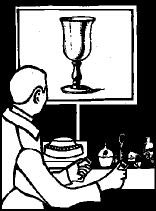SOMETIMES YOU have to hand it to the French. Insular, smug, and culturally arrogant they may often be; but they also don’t go in for guff about any attack on traditional values being tantamount to fomenting class warfare.
The most recent assault on a sacred French cow emerged against the unlikely background of a doctoral dissertation entitled “Taste: A Study in the Representation of Chemical Substances in the Arena of Consciousness.” Not, ordinarily, a subject to engage the deeper passions, but the author, Fr餩ric Brochet, was concerned not with taste in general but with taste as applied to the evaluation and appreciation of wine.
Brochet employed three distinct methodologies: computerized textual analysis of over 100,000 expert tasting notes (including 9,000 by American wine guru Robert M. Parker Jr.); comparison of ratings by expert tasters in totally blind and open tastings of the same wines; and real-time functional magnetic imaging of the brains of tasters in the act of tasting.
After appropriate statistical massaging, Brochet’s results prove that a lot of what wine connoisseurs say about wine is humbug: A side-by-side chart of best-to-worst rankings of 18 wines by a roster of experienced tasters showed about as much consistency as a table of random numbers.
To collect his own tasting data, Brochet played a couple pretty dirty tricks on his volunteers. In one tasting, he served a white wine and elicited all the usual descriptions: “fresh, dry, honeyed, lively.” Later he served the same wine dyed red: Out came the red terms: “intense, spicy, supple, deep.” In another test, he submitted a mid-range Bordeaux in two different bottles, one labeled as a cheap table wine, the other bearing a grand cru etiquette: Guess which one was “woody, complex, and round” and which was “short, light, and faulty”?
If Brochet had kept his findings in dissertation form, all might yet have been well in the land of fine vines. But he cheekily submitted it to Acad魩e Amorim, a Portuguese wine-cork-making firm which gives an annual prize to scholars its selection committee feels have made the greatest contribution to the science of wine. The grand prize for 2001 went to “a study of genetic polymorphism in the cultivated vine (Vitis vinifera L.) by means of microsatellite markers.” But Brochet’s little bombshell took runner-up position, and la merde promptly hit le ventilateur.
The press, predictably, has had a field day. “Drinkers have long suspected it, but now French researchers have finally proved it,” burbled the London Times‘ Adam Sage from Paris; “wine ‘experts’ know no more than the rest of us.” The same paper’s Kate Muir was even tarter in an item in her Diary column: “Following rigorous textual analysis of the Hachette, Parker, and Gault Millau wine guides, Brochet has concluded that their comments are ‘baloney.’ For this he gets a doctorate.”
Delightful as it is to catch masters of wine as red in the face as the (dyed) wine in their glasses, Brochet’s study aims to go beyond mere pantsing of poseurs. In the introduction to his prizewinning paper, he writes: “Tasting is [a form of] representation. Indeed, when our brain performs the task of ‘recognizing’ or ‘comprehending,’ it is manipulating representations. In reality, the taste of wine is a perceptual representation, because it manifests an interaction between consciousness and reality.”
OK, maybe you had to be there—or, better, read the whole essay, which is available on the Acad魩e Amorim Web site (www.academie-amorim.com). What Brochet’s study demonstrates is that science has so far illuminated little about how our brains turn experience into knowledge, and that if we’re not careful, attentive, and ever suspicious of our certainties, the evidence of our senses can’t begin to compete with the expectations planted in our conscious minds (often, without our noticing it, by others).
It’s much the same lesson taught by UW psych prof Elizabeth Loftus’ studies of how “eyewitnesses” can remember events they never saw: Words and concepts and expectations trump perception every time; and among the senses themselves, the eyes have it all over smell, taste, and touch.
Touch? You bet; almost all red wines have some tannins in them, extracted from the grape skins during fermentation along with the pigments that make them red in the first place. Tannins feel “rough” on the tongue. You’d think that anybody, let alone a veteran wine taster, would notice the absence of such a basic sensory datum.
And in fact, a small percentage of drinkers do. “About 2 to 3 percent of people detect the white wine flavor,” Brochet told an interviewer last month, “but invariably they have little experience with wine culture. . . . Connoisseurs, . . . the more training they have, the more mistakes they make.” Words to live by—and not just when drinking wine.
Roger Downey’s science column appears every other week.








